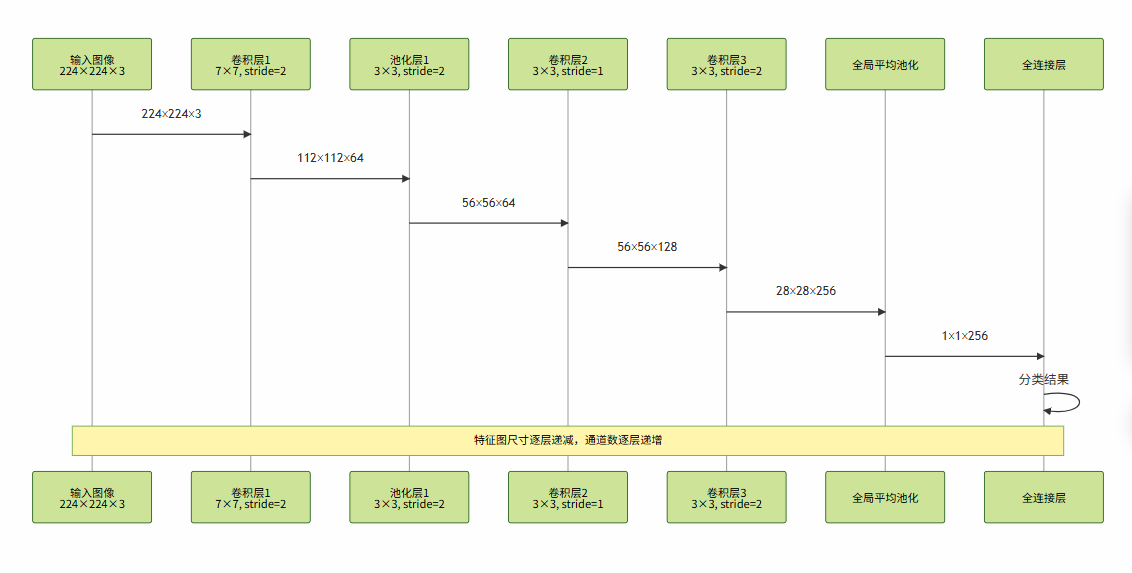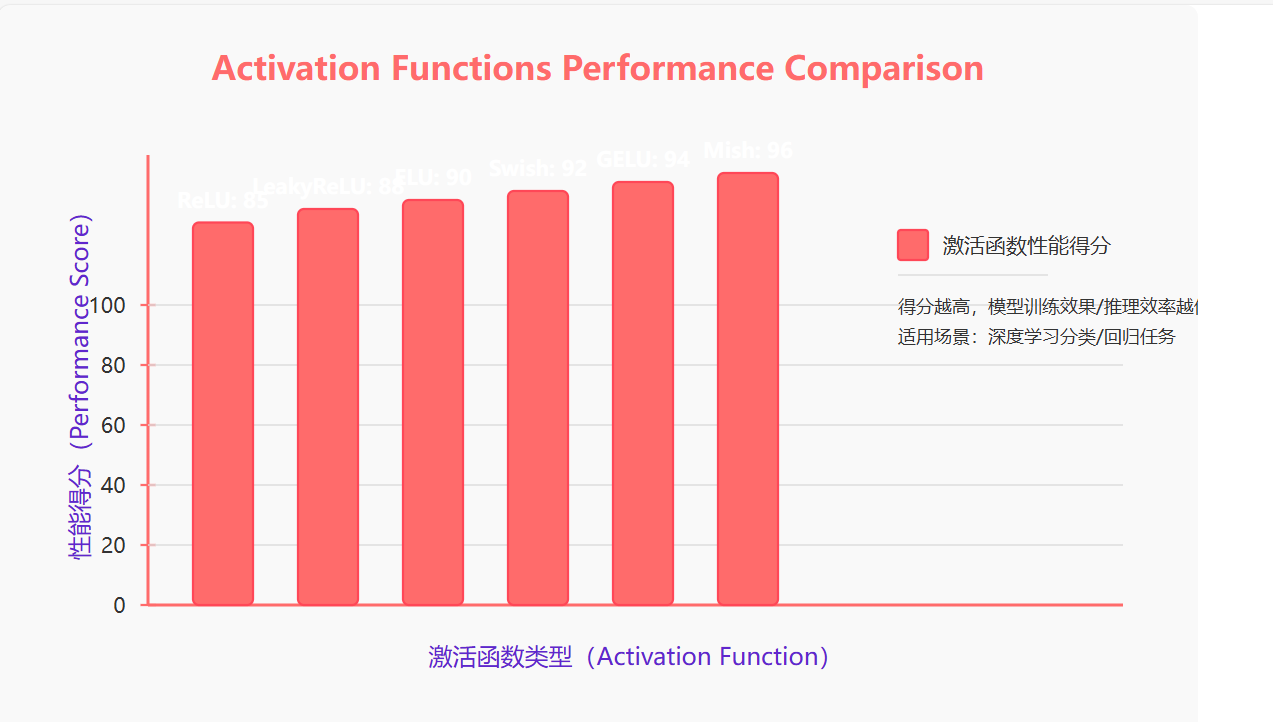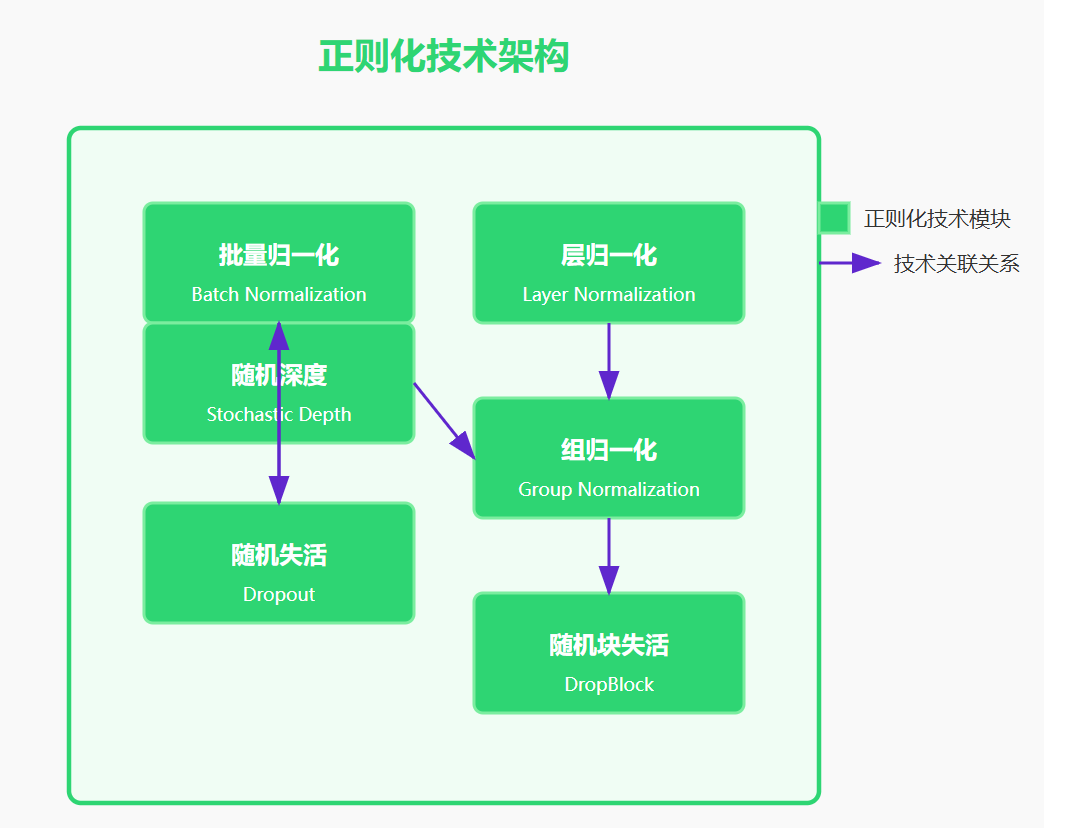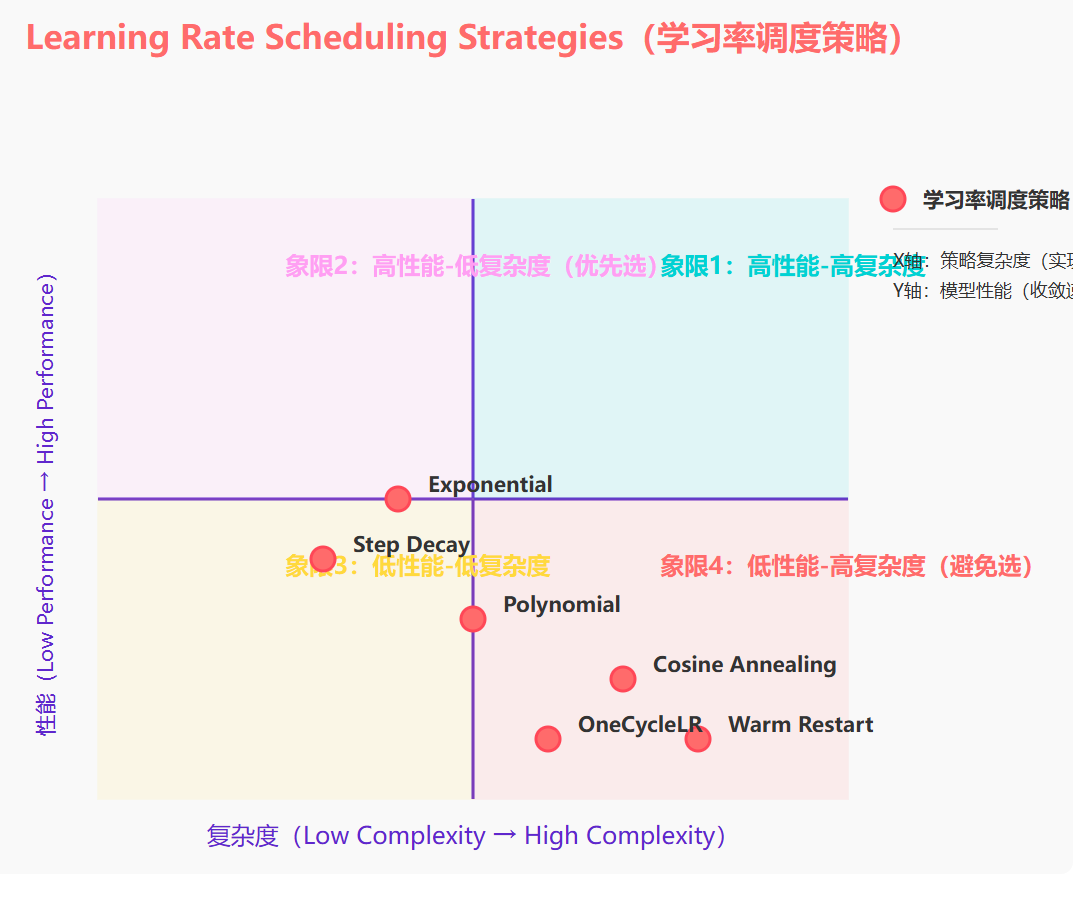卷积神经网络深度解析:从基础原理到实战应用的完整指南

🌟 Hello,我是蒋星熠Jaxonic!
🌈 在浩瀚无垠的技术宇宙中,我是一名执着的星际旅人,用代码绘制探索的轨迹。
🚀 每一个算法都是我点燃的推进器,每一行代码都是我航行的星图。
🔭 每一次性能优化都是我的天文望远镜,每一次架构设计都是我的引力弹弓。
🎻 在数字世界的协奏曲中,我既是作曲家也是首席乐手。让我们携手,在二进制星河中谱写属于极客的壮丽诗篇!
摘要
CNN不仅仅是一种算法,它更像是一把解锁视觉智能的钥匙,让机器拥有了"看见"和"理解"图像的能力。
在我的技术探索历程中,CNN始终是最令人着迷的领域之一。从最初的LeNet-5到如今的Vision Transformer,每一次架构创新都让我感受到技术进步的震撼。我记得第一次成功训练出能够识别手写数字的CNN模型时的兴奋,那种看着损失函数逐渐下降、准确率不断提升的成就感至今难忘。
CNN的核心思想源于生物视觉系统的启发,通过卷积操作、池化机制和层次化特征提取,模拟了人类视觉皮层的信息处理过程。这种设计不仅在理论上优雅,在实践中更是展现出了惊人的效果。从图像分类到目标检测,从医学影像分析到自动驾驶,CNN的应用领域之广泛令人叹为观止。
在本文中,我将带领大家深入CNN的技术内核,从数学原理到代码实现,从经典架构到最新发展,全方位解析这一改变世界的技术。我们将探讨卷积层的工作机制、池化操作的设计哲学、激活函数的选择策略,以及如何在实际项目中构建高效的CNN模型。通过丰富的代码示例和可视化图表,让每一个技术细节都变得清晰可见。
1. CNN基础原理与核心概念
1.1 卷积神经网络的生物学启发
卷积神经网络的设计灵感来源于生物视觉系统的研究。1962年,Hubel和Wiesel通过对猫视觉皮层的研究发现,视觉神经元具有局部感受野的特性,不同的神经元对特定的视觉模式(如边缘、角度)有选择性响应。
import numpy as np
import matplotlib.pyplot as plt
from scipy import ndimage# 模拟简单细胞的边缘检测功能
def simulate_simple_cell(image, orientation=0):"""模拟视觉皮层简单细胞的边缘检测功能Args:image: 输入图像orientation: 边缘方向(度)Returns:检测结果"""# 创建Gabor滤波器模拟简单细胞theta = np.radians(orientation)kernel_size = 9sigma = 2.0lambd = 4.0gamma = 0.5# 生成Gabor核x, y = np.meshgrid(np.arange(-kernel_size//2 + 1, kernel_size//2 + 1),np.arange(-kernel_size//2 + 1, kernel_size//2 + 1))x_theta = x * np.cos(theta) + y * np.sin(theta)y_theta = -x * np.sin(theta) + y * np.cos(theta)gabor = np.exp(-(x_theta**2 + gamma**2 * y_theta**2) / (2 * sigma**2)) * \np.cos(2 * np.pi * x_theta / lambd)# 应用滤波器response = ndimage.convolve(image, gabor, mode='constant')return response, gabor# 这段代码展示了如何模拟生物视觉系统中简单细胞的功能
# Gabor滤波器能够检测特定方向的边缘,这正是CNN卷积操作的生物学基础
1.2 卷积操作的数学原理
卷积操作是CNN的核心,其数学定义为:
(f∗g)(t)=∫−∞∞f(τ)g(t−τ)dτ(f * g)(t) = \int_{-\infty}^{\infty} f(\tau) g(t - \tau) d\tau (f∗g)(t)=∫−∞∞f(τ)g(t−τ)dτ
在离散情况下,二维卷积定义为:
S(i,j)=(I∗K)(i,j)=∑m∑nI(m,n)K(i−m,j−n)S(i,j) = (I * K)(i,j) = \sum_m \sum_n I(m,n)K(i-m,j-n) S(i,j)=(I∗K)(i,j)=m∑n∑I(m,n)K(i−m,j−n)
import torch
import torch.nn as nn
import torch.nn.functional as Fclass ConvolutionDemo:"""卷积操作演示类"""def __init__(self):self.device = torch.device('cuda' if torch.cuda.is_available() else 'cpu')def manual_convolution(self, input_tensor, kernel, stride=1, padding=0):"""手动实现卷积操作,帮助理解卷积的计算过程Args:input_tensor: 输入张量 (batch, channels, height, width)kernel: 卷积核 (out_channels, in_channels, kernel_h, kernel_w)stride: 步长padding: 填充Returns:卷积结果"""batch_size, in_channels, in_h, in_w = input_tensor.shapeout_channels, _, kernel_h, kernel_w = kernel.shape# 计算输出尺寸out_h = (in_h + 2 * padding - kernel_h) // stride + 1out_w = (in_w + 2 * padding - kernel_w) // stride + 1# 添加填充if padding > 0:input_tensor = F.pad(input_tensor, (padding, padding, padding, padding))# 初始化输出张量output = torch.zeros(batch_size, out_channels, out_h, out_w)# 执行卷积操作for b in range(batch_size):for oc in range(out_channels):for oh in range(out_h):for ow in range(out_w):h_start = oh * strideh_end = h_start + kernel_hw_start = ow * stridew_end = w_start + kernel_w# 提取感受野receptive_field = input_tensor[b, :, h_start:h_end, w_start:w_end]# 计算卷积output[b, oc, oh, ow] = torch.sum(receptive_field * kernel[oc])return outputdef demonstrate_feature_maps(self, input_image):"""演示不同卷积核产生的特征图"""# 定义不同类型的卷积核edge_kernels = {'horizontal_edge': torch.tensor([[-1, -1, -1], [0, 0, 0], [1, 1, 1]], dtype=torch.float32),'vertical_edge': torch.tensor([[-1, 0, 1], [-1, 0, 1], [-1, 0, 1]], dtype=torch.float32),'diagonal_edge': torch.tensor([[0, 1, 0], [1, 0, -1], [0, -1, 0]], dtype=torch.float32),'blur': torch.tensor([[1, 1, 1], [1, 1, 1], [1, 1, 1]], dtype=torch.float32) / 9}feature_maps = {}for name, kernel in edge_kernels.items():# 调整kernel形状以适应conv2dkernel = kernel.unsqueeze(0).unsqueeze(0) # (1, 1, 3, 3)feature_map = F.conv2d(input_image.unsqueeze(0).unsqueeze(0), kernel, padding=1)feature_maps[name] = feature_map.squeeze()return feature_maps# 这个类展示了卷积操作的核心机制
# 通过手动实现和特征图演示,帮助理解CNN如何提取图像特征
2. CNN架构设计与层次结构
2.1 经典CNN架构演进
图1:CNN架构演进时间线图 - 展示了从经典到现代CNN架构的发展历程
2.2 现代CNN架构实现
import torch
import torch.nn as nn
import torch.nn.functional as Fclass ResidualBlock(nn.Module):"""残差块实现 - ResNet的核心组件"""def __init__(self, in_channels, out_channels, stride=1, downsample=None):super(ResidualBlock, self).__init__()# 第一个卷积层self.conv1 = nn.Conv2d(in_channels, out_channels, kernel_size=3, stride=stride, padding=1, bias=False)self.bn1 = nn.BatchNorm2d(out_channels)# 第二个卷积层self.conv2 = nn.Conv2d(out_channels, out_channels, kernel_size=3, stride=1, padding=1, bias=False)self.bn2 = nn.BatchNorm2d(out_channels)# 下采样层(用于匹配维度)self.downsample = downsampleself.relu = nn.ReLU(inplace=True)def forward(self, x):identity = x# 第一个卷积块out = self.conv1(x)out = self.bn1(out)out = self.relu(out)# 第二个卷积块out = self.conv2(out)out = self.bn2(out)# 残差连接if self.downsample is not None:identity = self.downsample(x)out += identity # 关键的残差连接out = self.relu(out)return outclass ModernCNN(nn.Module):"""现代CNN架构,融合多种先进技术"""def __init__(self, num_classes=1000, dropout_rate=0.5):super(ModernCNN, self).__init__()# 初始卷积层self.conv1 = nn.Conv2d(3, 64, kernel_size=7, stride=2, padding=3, bias=False)self.bn1 = nn.BatchNorm2d(64)self.relu = nn.ReLU(inplace=True)self.maxpool = nn.MaxPool2d(kernel_size=3, stride=2, padding=1)# 残差层组self.layer1 = self._make_layer(64, 64, 2, stride=1)self.layer2 = self._make_layer(64, 128, 2, stride=2)self.layer3 = self._make_layer(128, 256, 2, stride=2)self.layer4 = self._make_layer(256, 512, 2, stride=2)# 全局平均池化self.avgpool = nn.AdaptiveAvgPool2d((1, 1))# 分类器self.dropout = nn.Dropout(dropout_rate)self.fc = nn.Linear(512, num_classes)# 权重初始化self._initialize_weights()def _make_layer(self, in_channels, out_channels, blocks, stride=1):"""构建残差层组"""downsample = Noneif stride != 1 or in_channels != out_channels:downsample = nn.Sequential(nn.Conv2d(in_channels, out_channels, kernel_size=1, stride=stride, bias=False),nn.BatchNorm2d(out_channels))layers = []layers.append(ResidualBlock(in_channels, out_channels, stride, downsample))for _ in range(1, blocks):layers.append(ResidualBlock(out_channels, out_channels))return nn.Sequential(*layers)def _initialize_weights(self):"""权重初始化"""for m in self.modules():if isinstance(m, nn.Conv2d):nn.init.kaiming_normal_(m.weight, mode='fan_out', nonlinearity='relu')elif isinstance(m, nn.BatchNorm2d):nn.init.constant_(m.weight, 1)nn.init.constant_(m.bias, 0)elif isinstance(m, nn.Linear):nn.init.normal_(m.weight, 0, 0.01)nn.init.constant_(m.bias, 0)def forward(self, x):# 特征提取x = self.conv1(x)x = self.bn1(x)x = self.relu(x)x = self.maxpool(x)x = self.layer1(x)x = self.layer2(x)x = self.layer3(x)x = self.layer4(x)# 分类x = self.avgpool(x)x = torch.flatten(x, 1)x = self.dropout(x)x = self.fc(x)return x# 这个实现展示了现代CNN的核心设计原则:
# 1. 残差连接解决梯度消失问题
# 2. 批归一化加速训练
# 3. 全局平均池化减少参数
# 4. 合理的权重初始化策略
3. 卷积层与特征提取机制
3.1 多尺度特征提取

图2:CNN特征提取流程时序图 - 展示了特征图在网络中的尺寸变化过程
3.2 注意力机制增强的卷积
class ChannelAttention(nn.Module):"""通道注意力机制"""def __init__(self, in_channels, reduction=16):super(ChannelAttention, self).__init__()self.avg_pool = nn.AdaptiveAvgPool2d(1)self.max_pool = nn.AdaptiveMaxPool2d(1)# 共享的MLPself.mlp = nn.Sequential(nn.Conv2d(in_channels, in_channels // reduction, 1, bias=False),nn.ReLU(inplace=True),nn.Conv2d(in_channels // reduction, in_channels, 1, bias=False))self.sigmoid = nn.Sigmoid()def forward(self, x):# 平均池化和最大池化avg_out = self.mlp(self.avg_pool(x))max_out = self.mlp(self.max_pool(x))# 融合并生成注意力权重out = avg_out + max_outreturn self.sigmoid(out)class SpatialAttention(nn.Module):"""空间注意力机制"""def __init__(self, kernel_size=7):super(SpatialAttention, self).__init__()self.conv = nn.Conv2d(2, 1, kernel_size, padding=kernel_size//2, bias=False)self.sigmoid = nn.Sigmoid()def forward(self, x):# 通道维度的平均和最大avg_out = torch.mean(x, dim=1, keepdim=True)max_out, _ = torch.max(x, dim=1, keepdim=True)# 拼接并卷积x_cat = torch.cat([avg_out, max_out], dim=1)out = self.conv(x_cat)return self.sigmoid(out)class CBAM(nn.Module):"""卷积块注意力模块 (Convolutional Block Attention Module)"""def __init__(self, in_channels, reduction=16, kernel_size=7):super(CBAM, self).__init__()self.channel_attention = ChannelAttention(in_channels, reduction)self.spatial_attention = SpatialAttention(kernel_size)def forward(self, x):# 通道注意力x = x * self.channel_attention(x)# 空间注意力x = x * self.spatial_attention(x)return xclass AttentionConvBlock(nn.Module):"""集成注意力机制的卷积块"""def __init__(self, in_channels, out_channels, stride=1):super(AttentionConvBlock, self).__init__()self.conv1 = nn.Conv2d(in_channels, out_channels, 3, stride, 1, bias=False)self.bn1 = nn.BatchNorm2d(out_channels)self.conv2 = nn.Conv2d(out_channels, out_channels, 3, 1, 1, bias=False)self.bn2 = nn.BatchNorm2d(out_channels)# 注意力机制self.cbam = CBAM(out_channels)# 残差连接的维度匹配self.shortcut = nn.Sequential()if stride != 1 or in_channels != out_channels:self.shortcut = nn.Sequential(nn.Conv2d(in_channels, out_channels, 1, stride, bias=False),nn.BatchNorm2d(out_channels))self.relu = nn.ReLU(inplace=True)def forward(self, x):identity = self.shortcut(x)out = self.relu(self.bn1(self.conv1(x)))out = self.bn2(self.conv2(out))# 应用注意力机制out = self.cbam(out)out += identityout = self.relu(out)return out# 注意力机制让CNN能够自适应地关注重要特征
# CBAM通过通道和空间两个维度的注意力,显著提升了特征表达能力
4. 池化操作与降维策略
4.1 池化操作对比分析
| 池化类型 | 计算方式 | 优势 | 劣势 | 适用场景 |
|---|---|---|---|---|
| 最大池化 | 取窗口最大值 | 保留显著特征,计算简单 | 丢失位置信息 | 目标检测、分类 |
| 平均池化 | 取窗口平均值 | 保留全局信息,平滑特征 | 可能模糊重要特征 | 全局特征提取 |
| 全局平均池化 | 整个特征图平均 | 大幅减少参数,防止过拟合 | 丢失空间结构 | 分类任务最后一层 |
| 自适应池化 | 自适应输出尺寸 | 处理任意输入尺寸 | 计算复杂度高 | 多尺度输入处理 |
| 随机池化 | 按概率选择 | 增强泛化能力 | 训练不稳定 | 数据增强 |
4.2 高级池化策略实现
class AdvancedPooling(nn.Module):"""高级池化策略集合"""def __init__(self, in_channels, pool_type='mixed'):super(AdvancedPooling, self).__init__()self.pool_type = pool_typeif pool_type == 'mixed':# 混合池化:结合最大池化和平均池化self.max_pool = nn.MaxPool2d(2, 2)self.avg_pool = nn.AvgPool2d(2, 2)self.conv_fusion = nn.Conv2d(in_channels * 2, in_channels, 1)elif pool_type == 'stochastic':# 随机池化实现self.pool_size = 2elif pool_type == 'learnable':# 可学习池化self.pool_weights = nn.Parameter(torch.randn(1, in_channels, 2, 2))elif pool_type == 'attention':# 注意力池化self.attention_conv = nn.Conv2d(in_channels, 1, 1)self.sigmoid = nn.Sigmoid()def forward(self, x):if self.pool_type == 'mixed':max_out = self.max_pool(x)avg_out = self.avg_pool(x)mixed = torch.cat([max_out, avg_out], dim=1)return self.conv_fusion(mixed)elif self.pool_type == 'stochastic':return self.stochastic_pooling(x)elif self.pool_type == 'learnable':return F.conv2d(x, self.pool_weights, stride=2, groups=x.size(1))elif self.pool_type == 'attention':attention_map = self.sigmoid(self.attention_conv(x))return F.adaptive_avg_pool2d(x * attention_map, (x.size(2)//2, x.size(3)//2))def stochastic_pooling(self, x):"""随机池化实现"""batch_size, channels, height, width = x.size()out_h, out_w = height // self.pool_size, width // self.pool_sizeoutput = torch.zeros(batch_size, channels, out_h, out_w, device=x.device)for i in range(out_h):for j in range(out_w):h_start = i * self.pool_sizeh_end = h_start + self.pool_sizew_start = j * self.pool_sizew_end = w_start + self.pool_sizepool_region = x[:, :, h_start:h_end, w_start:w_end]if self.training:# 训练时使用随机选择pool_flat = pool_region.view(batch_size, channels, -1)probs = F.softmax(pool_flat, dim=2)indices = torch.multinomial(probs.view(-1, self.pool_size**2), 1)indices = indices.view(batch_size, channels, 1)output[:, :, i, j] = torch.gather(pool_flat, 2, indices).squeeze(2)else:# 测试时使用期望值pool_flat = pool_region.view(batch_size, channels, -1)probs = F.softmax(pool_flat, dim=2)output[:, :, i, j] = torch.sum(pool_flat * probs, dim=2)return output# 这个实现展示了多种高级池化策略
# 每种策略都有其特定的应用场景和优势
5. 激活函数与非线性变换
5.1 激活函数性能对比

图3:激活函数性能对比图 - 展示了不同激活函数在深度网络中的表现
5.2 现代激活函数实现
import torch
import torch.nn as nn
import torch.nn.functional as F
import mathclass ModernActivations:"""现代激活函数集合"""@staticmethoddef swish(x, beta=1.0):"""Swish激活函数: x * sigmoid(β*x)"""return x * torch.sigmoid(beta * x)@staticmethoddef mish(x):"""Mish激活函数: x * tanh(softplus(x))"""return x * torch.tanh(F.softplus(x))@staticmethoddef gelu(x):"""GELU激活函数: 0.5 * x * (1 + tanh(√(2/π) * (x + 0.044715 * x³)))"""return 0.5 * x * (1 + torch.tanh(math.sqrt(2 / math.pi) * (x + 0.044715 * torch.pow(x, 3))))@staticmethoddef frelu(x, threshold=0.0):"""FReLU激活函数: max(x, threshold),threshold可学习"""return torch.max(x, threshold)class AdaptiveActivation(nn.Module):"""自适应激活函数"""def __init__(self, num_parameters=1, init_value=0.25):super(AdaptiveActivation, self).__init__()self.num_parameters = num_parametersself.weight = nn.Parameter(torch.ones(num_parameters) * init_value)def forward(self, x):# PReLU变体:f(x) = max(0, x) + a * min(0, x)return F.relu(x) + self.weight * F.relu(-x)class ActivationComparison:"""激活函数对比实验"""def __init__(self):self.activations = {'ReLU': nn.ReLU(),'LeakyReLU': nn.LeakyReLU(0.01),'ELU': nn.ELU(),'Swish': lambda x: ModernActivations.swish(x),'Mish': lambda x: ModernActivations.mish(x),'GELU': lambda x: ModernActivations.gelu(x),'Adaptive': AdaptiveActivation()}def compare_gradients(self, x_range=(-3, 3), num_points=1000):"""比较不同激活函数的梯度特性"""x = torch.linspace(x_range[0], x_range[1], num_points, requires_grad=True)results = {}for name, activation in self.activations.items():if isinstance(activation, nn.Module):y = activation(x)else:y = activation(x)# 计算梯度grad = torch.autograd.grad(y.sum(), x, create_graph=True)[0]results[name] = {'output': y.detach(),'gradient': grad.detach(),'dead_neurons': (grad == 0).float().mean().item()}return resultsdef benchmark_performance(self, input_tensor, iterations=1000):"""性能基准测试"""results = {}for name, activation in self.activations.items():# 预热for _ in range(10):if isinstance(activation, nn.Module):_ = activation(input_tensor)else:_ = activation(input_tensor)# 计时torch.cuda.synchronize() if torch.cuda.is_available() else Nonestart_time = torch.cuda.Event(enable_timing=True) if torch.cuda.is_available() else Noneend_time = torch.cuda.Event(enable_timing=True) if torch.cuda.is_available() else Noneif torch.cuda.is_available():start_time.record()for _ in range(iterations):if isinstance(activation, nn.Module):output = activation(input_tensor)else:output = activation(input_tensor)if torch.cuda.is_available():end_time.record()torch.cuda.synchronize()elapsed_time = start_time.elapsed_time(end_time)else:elapsed_time = 0 # CPU计时需要其他方法results[name] = {'time_ms': elapsed_time,'throughput': iterations / (elapsed_time / 1000) if elapsed_time > 0 else float('inf')}return results# 这个实现提供了全面的激活函数对比框架
# 包括梯度特性分析和性能基准测试
6. 批归一化与正则化技术
6.1 正则化技术架构图

图4:正则化技术架构图 - 展示了CNN中常用的正则化方法及其关系
6.2 高级正则化技术实现
class AdvancedNormalization(nn.Module):"""高级归一化技术集合"""def __init__(self, num_features, norm_type='batch', num_groups=32, eps=1e-5, momentum=0.1):super(AdvancedNormalization, self).__init__()self.norm_type = norm_typeself.num_features = num_featuresself.eps = epsif norm_type == 'batch':self.norm = nn.BatchNorm2d(num_features, eps=eps, momentum=momentum)elif norm_type == 'layer':self.norm = nn.LayerNorm([num_features], eps=eps)elif norm_type == 'group':self.norm = nn.GroupNorm(num_groups, num_features, eps=eps)elif norm_type == 'instance':self.norm = nn.InstanceNorm2d(num_features, eps=eps)elif norm_type == 'switchable':# 可切换归一化self.batch_norm = nn.BatchNorm2d(num_features, eps=eps, momentum=momentum)self.layer_norm = nn.LayerNorm([num_features], eps=eps)self.switch_weight = nn.Parameter(torch.tensor(0.5))def forward(self, x):if self.norm_type == 'switchable':# 动态选择归一化方式batch_out = self.batch_norm(x)# Layer norm需要调整维度b, c, h, w = x.size()layer_input = x.view(b, c, -1).transpose(1, 2) # (b, h*w, c)layer_out = self.layer_norm(layer_input)layer_out = layer_out.transpose(1, 2).view(b, c, h, w)# 加权融合return self.switch_weight * batch_out + (1 - self.switch_weight) * layer_outelse:if self.norm_type == 'layer':# Layer norm特殊处理b, c, h, w = x.size()x_reshaped = x.view(b, c, -1).transpose(1, 2)normalized = self.norm(x_reshaped)return normalized.transpose(1, 2).view(b, c, h, w)else:return self.norm(x)class DropBlock2D(nn.Module):"""DropBlock正则化 - 结构化的Dropout"""def __init__(self, drop_rate=0.1, block_size=7):super(DropBlock2D, self).__init__()self.drop_rate = drop_rateself.block_size = block_sizedef forward(self, x):if not self.training or self.drop_rate == 0:return x# 计算gamma参数gamma = self.drop_rate / (self.block_size ** 2)# 生成maskbatch_size, channels, height, width = x.size()# 采样中心点w = torch.rand(batch_size, channels, height - self.block_size + 1, width - self.block_size + 1, device=x.device)mask = (w < gamma).float()# 扩展mask到block大小mask = F.max_pool2d(mask, kernel_size=self.block_size, stride=1, padding=self.block_size // 2)# 确保mask尺寸匹配if mask.size() != x.size():mask = F.interpolate(mask, size=(height, width), mode='nearest')# 应用mask并重新缩放mask = 1 - maskreturn x * mask * mask.numel() / mask.sum()class StochasticDepth(nn.Module):"""随机深度 - 训练时随机跳过层"""def __init__(self, drop_prob=0.1):super(StochasticDepth, self).__init__()self.drop_prob = drop_probdef forward(self, x, residual):if not self.training or self.drop_prob == 0:return x + residual# 随机决定是否跳过if torch.rand(1).item() < self.drop_prob:return x # 跳过残差连接else:return x + residualclass RegularizedConvBlock(nn.Module):"""集成多种正则化技术的卷积块"""def __init__(self, in_channels, out_channels, stride=1, norm_type='batch', drop_rate=0.1, use_dropblock=True, stochastic_depth_prob=0.1):super(RegularizedConvBlock, self).__init__()# 卷积层self.conv1 = nn.Conv2d(in_channels, out_channels, 3, stride, 1, bias=False)self.norm1 = AdvancedNormalization(out_channels, norm_type)self.conv2 = nn.Conv2d(out_channels, out_channels, 3, 1, 1, bias=False)self.norm2 = AdvancedNormalization(out_channels, norm_type)# 正则化层if use_dropblock:self.dropout = DropBlock2D(drop_rate)else:self.dropout = nn.Dropout2d(drop_rate)self.stochastic_depth = StochasticDepth(stochastic_depth_prob)# 残差连接self.shortcut = nn.Sequential()if stride != 1 or in_channels != out_channels:self.shortcut = nn.Sequential(nn.Conv2d(in_channels, out_channels, 1, stride, bias=False),AdvancedNormalization(out_channels, norm_type))self.relu = nn.ReLU(inplace=True)def forward(self, x):identity = self.shortcut(x)out = self.relu(self.norm1(self.conv1(x)))out = self.dropout(out)out = self.norm2(self.conv2(out))# 使用随机深度out = self.stochastic_depth(identity, out)out = self.relu(out)return out# 这个实现展示了现代CNN中的高级正则化技术
# 包括多种归一化方法、结构化dropout和随机深度
7. CNN训练优化策略
7.1 学习率调度策略

图5:学习率调度策略象限图 - 展示了不同调度策略的复杂度与性能关系
7.2 高级训练策略实现
import torch.optim as optim
from torch.optim.lr_scheduler import _LRScheduler
import mathclass WarmupCosineAnnealingLR(_LRScheduler):"""带预热的余弦退火学习率调度器"""def __init__(self, optimizer, warmup_epochs, max_epochs, eta_min=0, last_epoch=-1):self.warmup_epochs = warmup_epochsself.max_epochs = max_epochsself.eta_min = eta_minsuper(WarmupCosineAnnealingLR, self).__init__(optimizer, last_epoch)def get_lr(self):if self.last_epoch < self.warmup_epochs:# 预热阶段:线性增长return [base_lr * (self.last_epoch + 1) / self.warmup_epochs for base_lr in self.base_lrs]else:# 余弦退火阶段progress = (self.last_epoch - self.warmup_epochs) / (self.max_epochs - self.warmup_epochs)return [self.eta_min + (base_lr - self.eta_min) * (1 + math.cos(math.pi * progress)) / 2 for base_lr in self.base_lrs]class AdaptiveTrainer:"""自适应CNN训练器"""def __init__(self, model, train_loader, val_loader, device='cuda'):self.model = model.to(device)self.train_loader = train_loaderself.val_loader = val_loaderself.device = device# 优化器配置self.optimizer = self._setup_optimizer()self.scheduler = self._setup_scheduler()self.criterion = nn.CrossEntropyLoss(label_smoothing=0.1)# 训练状态self.best_acc = 0.0self.patience = 0self.max_patience = 10# 混合精度训练self.scaler = torch.cuda.amp.GradScaler() if device == 'cuda' else Nonedef _setup_optimizer(self):"""设置优化器"""# 分层学习率:不同层使用不同学习率params = []# 预训练层使用较小学习率if hasattr(self.model, 'backbone'):params.append({'params': self.model.backbone.parameters(),'lr': 1e-4,'weight_decay': 1e-4})# 新增层使用较大学习率if hasattr(self.model, 'classifier'):params.append({'params': self.model.classifier.parameters(),'lr': 1e-3,'weight_decay': 1e-4})if not params:# 默认配置params = self.model.parameters()return optim.AdamW(params, lr=1e-3, weight_decay=1e-4, betas=(0.9, 0.999))def _setup_scheduler(self):"""设置学习率调度器"""return WarmupCosineAnnealingLR(self.optimizer, warmup_epochs=5, max_epochs=100,eta_min=1e-6)def train_epoch(self):"""训练一个epoch"""self.model.train()total_loss = 0.0correct = 0total = 0for batch_idx, (data, target) in enumerate(self.train_loader):data, target = data.to(self.device), target.to(self.device)self.optimizer.zero_grad()if self.scaler is not None:# 混合精度训练with torch.cuda.amp.autocast():output = self.model(data)loss = self.criterion(output, target)self.scaler.scale(loss).backward()# 梯度裁剪self.scaler.unscale_(self.optimizer)torch.nn.utils.clip_grad_norm_(self.model.parameters(), max_norm=1.0)self.scaler.step(self.optimizer)self.scaler.update()else:# 标准训练output = self.model(data)loss = self.criterion(output, target)loss.backward()# 梯度裁剪torch.nn.utils.clip_grad_norm_(self.model.parameters(), max_norm=1.0)self.optimizer.step()# 统计total_loss += loss.item()pred = output.argmax(dim=1, keepdim=True)correct += pred.eq(target.view_as(pred)).sum().item()total += target.size(0)return total_loss / len(self.train_loader), 100. * correct / totaldef validate(self):"""验证模型"""self.model.eval()total_loss = 0.0correct = 0total = 0with torch.no_grad():for data, target in self.val_loader:data, target = data.to(self.device), target.to(self.device)if self.scaler is not None:with torch.cuda.amp.autocast():output = self.model(data)loss = self.criterion(output, target)else:output = self.model(data)loss = self.criterion(output, target)total_loss += loss.item()pred = output.argmax(dim=1, keepdim=True)correct += pred.eq(target.view_as(pred)).sum().item()total += target.size(0)acc = 100. * correct / totalreturn total_loss / len(self.val_loader), accdef train(self, epochs=100):"""完整训练流程"""for epoch in range(epochs):# 训练train_loss, train_acc = self.train_epoch()# 验证val_loss, val_acc = self.validate()# 更新学习率self.scheduler.step()# 早停检查if val_acc > self.best_acc:self.best_acc = val_accself.patience = 0# 保存最佳模型torch.save(self.model.state_dict(), 'best_model.pth')else:self.patience += 1if self.patience >= self.max_patience:print(f"Early stopping at epoch {epoch}")break# 打印进度current_lr = self.optimizer.param_groups[0]['lr']print(f'Epoch {epoch}: Train Loss: {train_loss:.4f}, Train Acc: {train_acc:.2f}%, 'f'Val Loss: {val_loss:.4f}, Val Acc: {val_acc:.2f}%, LR: {current_lr:.6f}')# 这个训练器集成了现代深度学习的最佳实践
# 包括混合精度训练、梯度裁剪、学习率预热等技术
8. CNN实际应用案例
8.1 图像分类完整实现
import torchvision.transforms as transforms
from torch.utils.data import DataLoader
import torchvision.datasets as datasetsclass ImageClassificationPipeline:"""图像分类完整流水线"""def __init__(self, num_classes=10, input_size=224):self.num_classes = num_classesself.input_size = input_sizeself.device = torch.device('cuda' if torch.cuda.is_available() else 'cpu')# 数据预处理self.train_transform = transforms.Compose([transforms.Resize((input_size, input_size)),transforms.RandomHorizontalFlip(p=0.5),transforms.RandomRotation(degrees=15),transforms.ColorJitter(brightness=0.2, contrast=0.2, saturation=0.2, hue=0.1),transforms.RandomAffine(degrees=0, translate=(0.1, 0.1), scale=(0.9, 1.1)),transforms.ToTensor(),transforms.Normalize(mean=[0.485, 0.456, 0.406], std=[0.229, 0.224, 0.225]),transforms.RandomErasing(p=0.2, scale=(0.02, 0.33), ratio=(0.3, 3.3))])self.val_transform = transforms.Compose([transforms.Resize((input_size, input_size)),transforms.ToTensor(),transforms.Normalize(mean=[0.485, 0.456, 0.406], std=[0.229, 0.224, 0.225])])# 构建模型self.model = self._build_model()def _build_model(self):"""构建分类模型"""model = ModernCNN(num_classes=self.num_classes)return model.to(self.device)def prepare_data(self, data_dir, batch_size=32, num_workers=4):"""准备数据加载器"""# 训练集train_dataset = datasets.ImageFolder(root=f'{data_dir}/train',transform=self.train_transform)# 验证集val_dataset = datasets.ImageFolder(root=f'{data_dir}/val',transform=self.val_transform)# 数据加载器train_loader = DataLoader(train_dataset, batch_size=batch_size, shuffle=True,num_workers=num_workers, pin_memory=True)val_loader = DataLoader(val_dataset, batch_size=batch_size, shuffle=False,num_workers=num_workers, pin_memory=True)return train_loader, val_loaderdef train_model(self, train_loader, val_loader, epochs=100):"""训练模型"""trainer = AdaptiveTrainer(self.model, train_loader, val_loader, self.device)trainer.train(epochs)return trainer.best_accdef evaluate_model(self, test_loader):"""评估模型性能"""self.model.eval()all_preds = []all_labels = []with torch.no_grad():for data, target in test_loader:data, target = data.to(self.device), target.to(self.device)output = self.model(data)pred = output.argmax(dim=1)all_preds.extend(pred.cpu().numpy())all_labels.extend(target.cpu().numpy())# 计算各种指标from sklearn.metrics import accuracy_score, precision_recall_fscore_support, confusion_matrixaccuracy = accuracy_score(all_labels, all_preds)precision, recall, f1, _ = precision_recall_fscore_support(all_labels, all_preds, average='weighted')cm = confusion_matrix(all_labels, all_preds)return {'accuracy': accuracy,'precision': precision,'recall': recall,'f1_score': f1,'confusion_matrix': cm}def predict_single_image(self, image_path):"""单张图像预测"""from PIL import Image# 加载和预处理图像image = Image.open(image_path).convert('RGB')input_tensor = self.val_transform(image).unsqueeze(0).to(self.device)# 预测self.model.eval()with torch.no_grad():output = self.model(input_tensor)probabilities = F.softmax(output, dim=1)predicted_class = output.argmax(dim=1).item()confidence = probabilities[0][predicted_class].item()return predicted_class, confidence, probabilities.cpu().numpy()[0]# 使用示例
if __name__ == "__main__":# 创建分类流水线pipeline = ImageClassificationPipeline(num_classes=10)# 准备数据train_loader, val_loader = pipeline.prepare_data('path/to/dataset')# 训练模型best_accuracy = pipeline.train_model(train_loader, val_loader)print(f"Best validation accuracy: {best_accuracy:.2f}%")# 评估模型metrics = pipeline.evaluate_model(val_loader)print(f"Test metrics: {metrics}")# 这个完整的实现展示了CNN在图像分类任务中的应用
# 包括数据预处理、模型训练、评估和预测的完整流程
深度学习的本质不在于模仿人脑,而在于发现数据中的模式。CNN通过层次化的特征学习,让机器拥有了超越人类的视觉感知能力。 —— Geoffrey Hinton
9. 性能优化与部署策略
9.1 模型压缩技术对比
| 压缩技术 | 压缩比 | 精度损失 | 推理速度提升 | 内存节省 | 实现复杂度 |
|---|---|---|---|---|---|
| 量化 | 2-4x | 1-3% | 2-3x | 50-75% | 中等 |
| 剪枝 | 2-10x | 2-5% | 1.5-3x | 60-90% | 高 |
| 知识蒸馏 | 3-5x | 1-2% | 3-5x | 70-80% | 中等 |
| 低秩分解 | 1.5-3x | 0.5-2% | 1.2-2x | 30-60% | 低 |
| 神经架构搜索 | 2-4x | 0-1% | 2-4x | 50-75% | 极高 |
9.2 模型优化实现
import torch.quantization as quantization
from torch.nn.utils import pruneclass ModelOptimizer:"""CNN模型优化器"""def __init__(self, model):self.model = modelself.original_size = self._get_model_size()def _get_model_size(self):"""计算模型大小(MB)"""param_size = 0buffer_size = 0for param in self.model.parameters():param_size += param.nelement() * param.element_size()for buffer in self.model.buffers():buffer_size += buffer.nelement() * buffer.element_size()return (param_size + buffer_size) / 1024 / 1024def quantize_model(self, calibration_loader=None):"""模型量化"""# 准备量化self.model.eval()# 动态量化(推理时量化)quantized_model = quantization.quantize_dynamic(self.model, {nn.Conv2d, nn.Linear}, dtype=torch.qint8)# 如果有校准数据,使用静态量化if calibration_loader is not None:# 设置量化配置self.model.qconfig = quantization.get_default_qconfig('fbgemm')# 准备量化quantization.prepare(self.model, inplace=True)# 校准with torch.no_grad():for data, _ in calibration_loader:self.model(data)# 转换为量化模型quantized_model = quantization.convert(self.model, inplace=False)return quantized_modeldef prune_model(self, pruning_ratio=0.3):"""模型剪枝"""# 结构化剪枝:移除整个通道for name, module in self.model.named_modules():if isinstance(module, nn.Conv2d):# L1非结构化剪枝prune.l1_unstructured(module, name='weight', amount=pruning_ratio)# 移除剪枝mask,永久删除权重prune.remove(module, 'weight')return self.modeldef knowledge_distillation(self, teacher_model, student_model, train_loader, temperature=4.0, alpha=0.7, epochs=50):"""知识蒸馏"""teacher_model.eval()student_model.train()optimizer = optim.Adam(student_model.parameters(), lr=1e-3)criterion_ce = nn.CrossEntropyLoss()criterion_kd = nn.KLDivLoss(reduction='batchmean')for epoch in range(epochs):total_loss = 0.0for data, target in train_loader:optimizer.zero_grad()# 学生模型输出student_output = student_model(data)# 教师模型输出(不计算梯度)with torch.no_grad():teacher_output = teacher_model(data)# 计算损失# 1. 标准交叉熵损失ce_loss = criterion_ce(student_output, target)# 2. 知识蒸馏损失student_soft = F.log_softmax(student_output / temperature, dim=1)teacher_soft = F.softmax(teacher_output / temperature, dim=1)kd_loss = criterion_kd(student_soft, teacher_soft) * (temperature ** 2)# 3. 总损失loss = alpha * kd_loss + (1 - alpha) * ce_lossloss.backward()optimizer.step()total_loss += loss.item()print(f'Epoch {epoch}: Loss = {total_loss / len(train_loader):.4f}')return student_modeldef optimize_for_inference(self, example_input):"""推理优化"""# 1. 模型融合self.model.eval()# 融合Conv-BN-ReLUfor name, module in self.model.named_modules():if isinstance(module, nn.Sequential):# 检查是否为Conv-BN-ReLU模式if (len(module) >= 2 and isinstance(module[0], nn.Conv2d) and isinstance(module[1], nn.BatchNorm2d)):# 融合Conv和BNconv = module[0]bn = module[1]# 计算融合后的权重和偏置w_conv = conv.weight.clone()if conv.bias is not None:b_conv = conv.bias.clone()else:b_conv = torch.zeros_like(bn.running_mean)w_bn = bn.weight.clone()b_bn = bn.bias.clone()running_mean = bn.running_mean.clone()running_var = bn.running_var.clone()eps = bn.eps# 融合公式std = torch.sqrt(running_var + eps)w_fused = w_conv * (w_bn / std).view(-1, 1, 1, 1)b_fused = (b_conv - running_mean) * w_bn / std + b_bn# 创建新的融合层fused_conv = nn.Conv2d(conv.in_channels, conv.out_channels,conv.kernel_size, conv.stride, conv.padding,bias=True)fused_conv.weight.data = w_fusedfused_conv.bias.data = b_fused# 替换原始模块setattr(self.model, name.split('.')[-1], fused_conv)# 2. TorchScript编译traced_model = torch.jit.trace(self.model, example_input)# 3. 图优化optimized_model = torch.jit.optimize_for_inference(traced_model)return optimized_modeldef benchmark_performance(self, model, example_input, iterations=1000):"""性能基准测试"""model.eval()# 预热with torch.no_grad():for _ in range(10):_ = model(example_input)# 计时torch.cuda.synchronize() if torch.cuda.is_available() else Nonestart_time = torch.cuda.Event(enable_timing=True) if torch.cuda.is_available() else Noneend_time = torch.cuda.Event(enable_timing=True) if torch.cuda.is_available() else Noneif torch.cuda.is_available():start_time.record()with torch.no_grad():for _ in range(iterations):output = model(example_input)if torch.cuda.is_available():end_time.record()torch.cuda.synchronize()elapsed_time = start_time.elapsed_time(end_time)else:elapsed_time = 0# 计算指标avg_time = elapsed_time / iterations if elapsed_time > 0 else 0throughput = iterations / (elapsed_time / 1000) if elapsed_time > 0 else float('inf')model_size = self._get_model_size()return {'avg_inference_time_ms': avg_time,'throughput_fps': throughput,'model_size_mb': model_size,'compression_ratio': self.original_size / model_size}# 使用示例
optimizer = ModelOptimizer(model)# 量化优化
quantized_model = optimizer.quantize_model(calibration_loader)# 剪枝优化
pruned_model = optimizer.prune_model(pruning_ratio=0.3)# 推理优化
optimized_model = optimizer.optimize_for_inference(example_input)# 性能测试
metrics = optimizer.benchmark_performance(optimized_model, example_input)
print(f"Optimization results: {metrics}")# 这个优化器提供了全面的模型压缩和加速方案
# 可以根据具体需求选择合适的优化策略
10. 未来发展趋势与展望
10.1 CNN技术发展路线图

图6:CNN技术发展时间线 - 展示了从过去到未来的技术演进路径
总结
从最初的生物学启发到如今的工程化应用,CNN不仅改变了计算机视觉的面貌,更重要的是,它为我们打开了通向人工智能未来的大门。
在这篇文章中,我们从CNN的基础原理出发,深入探讨了卷积操作的数学本质,理解了为什么这种看似简单的操作能够如此有效地提取图像特征。我们见证了从LeNet到ResNet,从传统架构到注意力机制的演进历程,每一次创新都代表着人类对视觉智能理解的深化。
特别令我印象深刻的是现代CNN中的各种优化技术。残差连接解决了深度网络的梯度消失问题,批归一化加速了训练过程,注意力机制让模型能够自适应地关注重要特征。这些技术的结合,使得CNN在各种视觉任务中都能取得卓越的性能。
在实际应用层面,我们探讨了从数据预处理到模型部署的完整流程。混合精度训练、学习率调度、模型压缩等技术的应用,让CNN能够在资源受限的环境中高效运行。这些工程化的实践经验,对于将研究成果转化为实际产品具有重要意义。
展望未来,CNN技术仍在快速发展。Vision Transformer的出现虽然挑战了CNN的地位,但也促进了两者的融合创新。ConvNeXt等新架构证明了CNN仍有巨大的潜力。神经架构搜索、量子计算、脑启发计算等前沿技术,将为CNN的发展带来新的机遇。
作为一名技术探索者,我相信CNN的故事远未结束。在人工智能的星辰大海中,CNN将继续发挥重要作用,与其他技术协同发展,共同推动智能时代的到来。让我们继续在这个充满挑战和机遇的领域中探索前行,用代码和算法书写属于我们这个时代的技术传奇。
■ 我是蒋星熠Jaxonic!如果这篇文章在你的技术成长路上留下了印记
■ 👁 【关注】与我一起探索技术的无限可能,见证每一次突破
■ 👍 【点赞】为优质技术内容点亮明灯,传递知识的力量
■ 🔖 【收藏】将精华内容珍藏,随时回顾技术要点
■ 💬 【评论】分享你的独特见解,让思维碰撞出智慧火花
■ 🗳 【投票】用你的选择为技术社区贡献一份力量
■ 技术路漫漫,让我们携手前行,在代码的世界里摘取属于程序员的那片星辰大海!
参考链接
- Deep Learning - Ian Goodfellow, Yoshua Bengio, Aaron Courville
- PyTorch官方文档 - 卷积神经网络教程
- Papers With Code - CNN架构排行榜
- Distill.pub - CNN可视化解释
- Google AI Blog - EfficientNet架构详解
关键词标签
#卷积神经网络 #深度学习 #计算机视觉 #神经网络架构 #模型优化
